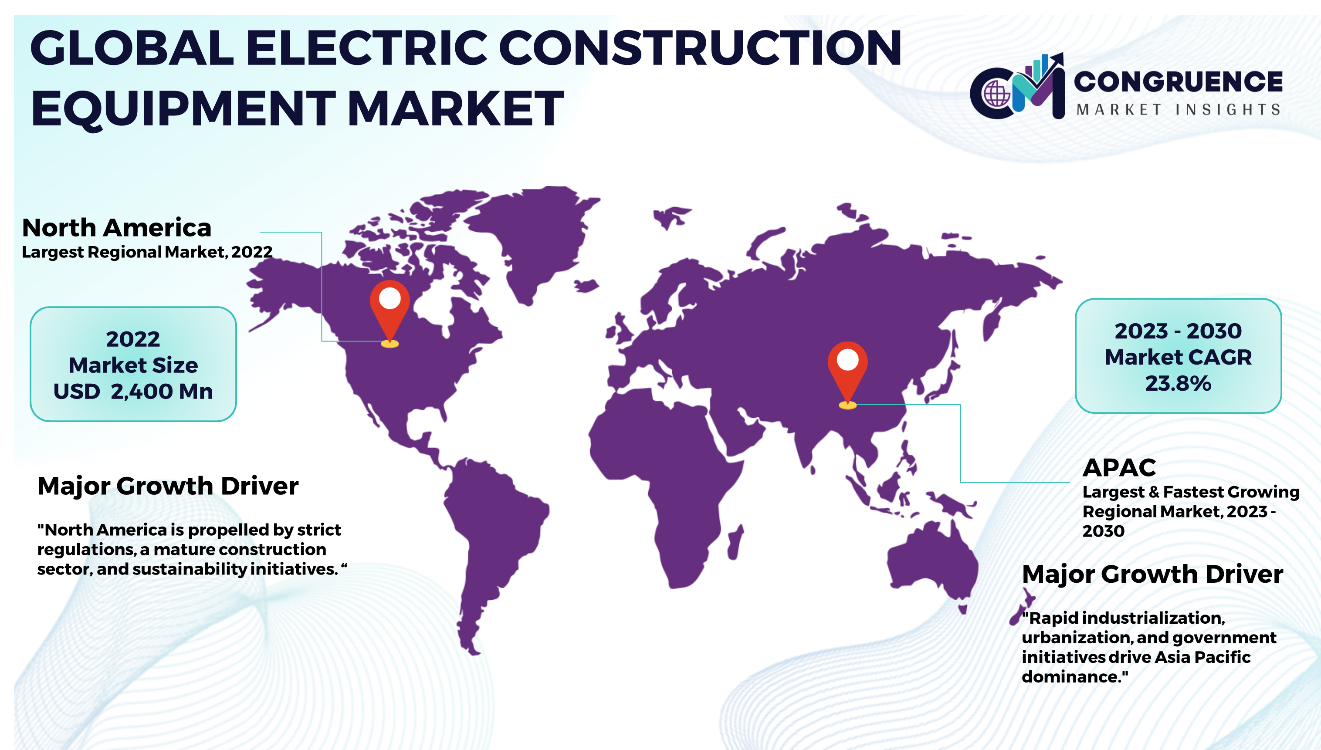Reports
The Global Electric Construction Equipment Market was valued at USD 8,300.0 Million in 2022 and is anticipated to reach a value of USD 42,885.2 Million by 2030 expanding at a CAGR of 23.5% between 2023 and 2030.
The global market for electric construction equipment is undergoing a significant transformation, propelled by an emphasis on environmental sustainability, stringent emissions regulations, and advancements in electric vehicle technology. Demonstrating a robust growth trajectory, this market is witnessing increased adoption across residential, commercial, and industrial construction sectors. Electric construction equipment, encompassing excavators, loaders, dozers, cranes, and specialized machinery, is gaining prominence for its capacity to diminish carbon footprints, reduce noise levels, and align with evolving environmental standards. In the realm of urban and residential construction, electric mini excavators and loaders have emerged as preferred choices, effectively addressing concerns related to noise pollution and emissions in densely populated areas. The commercial sector is experiencing a gradual embrace of electric equipment, fueled by corporate sustainability initiatives and regulatory incentives. Concurrently, industrial construction projects, spanning infrastructure development and manufacturing plant construction, are also integrating electric machinery, with hybrid and plug-in electric solutions tailored for heavy-duty applications.
Governments worldwide are actively encouraging the adoption of electric construction equipment through subsidies, tax breaks, and favorable policies, propelling market growth. Leading industry players are channeling investments into research and development to enhance battery technology, extend operational ranges, and enhance overall efficiency. With the global expansion of infrastructure for electric charging networks, the electric construction equipment market is poised for sustained growth, offering an enticing blend of performance, environmental advantages, and long-term cost savings for the construction industry.

Electric Construction Equipment Market Major Driving Forces
Environmental Regulations and Sustainability Initiatives: Stringent environmental regulations and a global push toward sustainability drive the adoption of electric construction equipment. Governments worldwide are implementing policies to reduce emissions and promote eco-friendly construction practices.
Advancements in Battery Technology: Ongoing improvements in battery technology, including increased energy density, faster charging capabilities, and extended battery life, enhance the efficiency and viability of electric construction equipment. These advancements address concerns related to range, charging time, and overall performance.
Technological Innovations: Continuous innovation in electric construction equipment, including the development of new models, features, and functionalities, enhances the overall appeal and competitiveness of these machines in the market. This includes advancements in automation, telematics, and connectivity.
Infrastructure Development for Charging: The expansion of charging infrastructure globally facilitates the adoption of electric construction equipment. Improved access to charging stations supports the operational needs of electric machinery, especially in urban areas.
Electric Construction Equipment Market Key Opportunities
Urban and Residential Construction: In urban and residential construction projects where environmental concerns and noise reduction are paramount, there is a substantial demand for electric construction equipment. Compact electric machinery, such as mini excavators and loaders, holds increased potential for applications in these settings.
Technological Advancements: The ongoing progress in battery technology, automation, and connectivity provides manufacturers with opportunities to elevate the performance, efficiency, and features of electric construction equipment. Innovations in telematics and data analytics have the potential to enhance fleet management and overall operational efficiency.
Expansion of charging infrastructure: The continuous expansion of charging infrastructure on a global scale creates opportunities for the widespread adoption of electric construction equipment. The growth of charging networks in construction sites and urban areas serves to support the operational requirements of electric machinery.
Electric Construction Equipment Market Key Trends
· Continuous progress in power storage technology, marked by increased energy density, faster charging capabilities, and enhanced battery life, remains a pivotal trend shaping the electric construction equipment market.
· A rising trend involves the integration of telematics and the Internet of Things (IoT) within electric construction equipment.
· A notable trend in the market is the evolution of all-inclusive hybrid electric solutions, amalgamating traditional internal combustion engines with electric power.
· Electric construction equipment is witnessing a notable trend with the integration of autonomous and semi-autonomous systems.
· Electric construction equipment aligns seamlessly with these practices, actively reducing emissions, noise levels, and overall environmental impact in construction operations.
· An emerging trend pertains to the development and adoption of advanced heavy-duty electric construction equipment, encompassing substantial machinery such as large excavators, bulldozers, and cranes. The progress in battery technology is instrumental in enabling the electrification of heavier equipment for a broader spectrum of construction projects.
Region-wise Market Insights
Asia Pacific accounted for the largest market share at 35.6% in 2022 and is expected to register the fastest growth, expanding at a CAGR of 23.8% between 2023 and 2030.

Asia Pacific emerges as the leading force, commanding a significant market share due to rapid industrialization, urbanization, and extensive infrastructural development in key economies. Governments in the region actively advocate for the adoption of electric vehicles and construction machinery, creating an environment conducive to market expansion. Asia Pacific solidifies its status as a major innovation hub for electric construction equipment, benefiting from a strong presence in manufacturing industries and continuous advancements in battery technology.
In close pursuit, North America witnesses a surge in demand for electric machinery driven by strict environmental regulations, a well-established construction sector, and an increasing focus on sustainability. Particularly, the United States and Canada attract heightened interest from construction companies prioritizing environmentally friendly practices.
Similarly, in Europe, a comparable trend unfolds as Germany, the United Kingdom, and France take the lead in embracing electric construction equipment. The European Union's rigorous emissions standards and comprehensive sustainability initiatives significantly contribute to the region's steady growth.
South America and the Middle East & Africa exhibit a gradual yet promising adoption of electric construction equipment, fueled by a growing awareness of environmental issues and an increasing commitment to sustainable practices. These regions offer untapped potential, with governments progressively incentivizing the transition to electric machinery. While Asia Pacific maintains its dominance, regional nuances underscore a global shift toward sustainable construction practices and the widespread integration of electric construction equipment.
Segment-wise Market Analysis
· Excavators take center stage as a largest segment in the Electric Construction Equipment market. Owing to their versatility and critical role in construction operations. Electric excavators offer enhanced efficiency, reduced emissions, and lower operational costs compared to traditional counterparts. With advancements in battery technology and increasing emphasis on sustainability, electric excavators stand out as a preferred choice for construction projects worldwide, driving their prominence in the evolving electric construction equipment landscape.
· Battery-powered electric construction equipment takes the lead as the dominant power source in the Global Electric Construction Equipment Market. The surge in demand is fueled by advancements in battery technology, providing efficient energy storage solutions. This power source offers versatility, reduced emissions, and operational cost benefits. With a growing emphasis on sustainability, battery-powered equipment emerges as the preferred choice, shaping the market's landscape and paving the way for a greener construction industry.
Market Competition Landscape
The Electric Construction Equipment Market is marked by fierce competition and a dynamic landscape shaped by key industry players. Market leaders, such as AB Volvo, Komatsu, Caterpillar, Liebherr, Deere & Company, and others are pivotal in shaping the electric construction equipment market. Their focus on innovation, sustainable practices, and global impact sets industry standards. The entry of new players, encompassing startups and regional entities, adds diversity to the competitive environment, introducing specialized offerings and driving innovation. Collaborations between equipment manufacturers and technology firms are widespread, facilitating the integration of advanced features like telematics and autonomous capabilities. Market dynamics are further influenced by regulatory requirements, prompting companies to align strategies with stringent emission standards and sustainability objectives. The global push for electric vehicle adoption and infrastructure development amplifies competition. Concurrently, substantial investments in research and development for battery technology and charging infrastructure underscore the competitive landscape. As the market progresses, competition remains a compelling force, urging companies to distinguish themselves through technological advancements, sustainability initiatives, and strategic alliances to secure a prominent standing in the rapidly expanding Electric Construction Equipment Market.
Key players in the global electric construction equipment market implement various organic and inorganic strategies to strengthen and improve their market positioning. Prominent players in the market include:
· AB Volvo
· Komatsu
· Caterpillar
· Liebherr
· Deere & Company
· XCMG Group
· J C Bamford Excavators Ltd.
· Zoomlion Heavy Industry Science&Technology Co., Ltd.
· Staad Groep
· Hitachi Construction Machinery Co., Ltd.
· Mitsubishi Electric Corporation
|
Report Attribute/Metric |
Details |
|
Market Revenue in 2022 |
USD 8,300.0 Million |
|
Market Revenue in 2030 |
USD 42,885.2 Million |
|
CAGR (2023 – 2030) |
23.5% |
|
Base Year |
2022 |
|
Forecast Period |
2023 – 2030 |
|
Historical Data |
2018 to 2022 |
|
Forecast Unit |
Value (US$ Mn) |
|
Key Report Deliverable |
Revenue Forecast, Growth Trends, Market Dynamics, Segmental Overview, Regional and Country-wise Analysis, Competition Landscape |
|
Segments Covered |
· By Product Type (Excavators, Dozers, Cranes, Loaders, Forklifts, and Others) · By Power Source (Battery Powered, Hybrid Electric, and Plug-In Electric) · By Application (New Construction, and Renovation/Remodeling) · By End Use (Residential, Commercial, and Industrial) |
|
Geographies Covered |
North America: U.S., Canada and Mexico Europe: Germany, France, U.K., Italy, Spain, and Rest of Europe Asia Pacific: China, India, Japan, South Korea, Southeast Asia, and Rest of Asia Pacific South America: Brazil, Argentina, and Rest of Latin America Middle East & Africa: GCC Countries, South Africa, and Rest of Middle East & Africa |
|
Key Players Analyzed |
AB Volvo, Komatsu, Caterpillar, Liebherr, Deere & Company, XCMG Group, J C Bamford Excavators Ltd., Zoomlion Heavy Industry Science&Technology Co., Ltd., Staad Groep, Hitachi Construction Machinery Co., Ltd., Mitsubishi Electric Corporation, and Others |
|
Customization & Pricing |
Available on Request (10% Customization is Free) |
